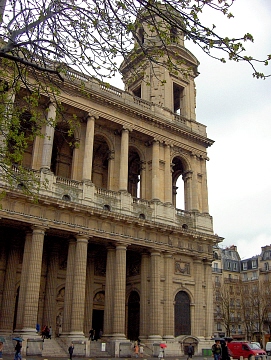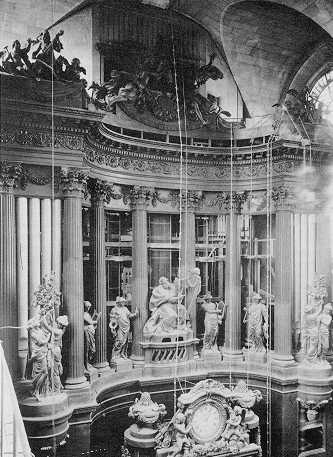Latin Quarter - Saint Sulpice


Begun by Gamart in 1646, then continued by many other architects including Le Vau, the church of St. Sulpice has been reimagined and rebuilt many times through the years. The current sanctuary was begun by Gittard in 1660. The nave and the wings of the church were built in the 18th century, around the same time when the painter Servandini was commissioned to build the church's fa‡ade in an "antique" style. The facade today is made up of three levels; the bottom two are made of columns and are crowned by two towers. Design and construction was modified by Chalgrin before its completion. The interior of the cathedral is magnificent and impressive. Its singular decor includes the murals painted by Eugene Delacroix in the Chapelle des Anges (Chapel of Angels).
There is a meridian line, on the left side of the church, called the Astronomical Gneomen. Apparently, it was commissioned in order to determine the exact date of Easter, and the winter and summer equinoxes.
The Church is also known for its organ, the largest in Europe, and both the music and the choir have been praised by French writers for generations.

The organ tradition of St. Sulpice dates back a long time. From the mid 16th century we can observe the presence of an organist. Then the well known Guillaume-Gabriel Nivers and Louis-Nicolas Clerambault follow. But these organists served the first parrish church of St. Sulpice. The current church building, built during the mid 18th century according to the design of the architect Chalgrin, contains the monumental organ case (also designed by Chalgrin) that we can admire to this day. This case originally contained an instrument built in 1781 by Clicquot, with five manuals, 64 stops, and a Montre of 32 ft. The organ was considered one the finest organs of the French kingdom, along with those of Saint-Martin de Tours and Notre-Dame de Paris. Thanks to the talent of its organist, Nicolas Sejan, the instrument became celebrated throughout Europe.
During the 19th century, the famous organ builder Aristide Cavaille-Coll constructed a new instrument that conserved much of the previous organ, with the intention of realizing the union of the "older art with the new." Thus the Grand-Orgue of St. Sulpice, one of the three "100 stop" European organs accompanied by Ulm Cathedral (Walcker) and Liverpool Cathedral (Willis), rapidly became admired throughout the world. Professor Adolphe Hesse of Breslau, a noted performer of Bach who had visited the organ just after its completion, wrote: "I must declare that of all of the instruments that I have seen, examined, and played, that of St. Sulpice is the most perfect, harmonious, largest, and really the master work of modern organ building."
In 1863, the brilliant virtuoso Lefebure-Wely was nominated organist. He was succeeded in 1870 by Charles-Marie Widor who was only 26 years old. Nominated with the title as a "temporary organist," he was never given the official title of "titular" during his 63 year presence at St. Sulpice! He resigned on the 31 December 1933, handing the post over to Marcel Dupre, another great figure in the organ world. Dupre died during the afternoon of the Pentecote in 1971 after playing for the mass that morning. He was succeeded by his student, Jean-Jacques Grunenwald, another great musician who would only hold the post for ten years. These artists, with high regard for Cavaille-Coll's work, had left the instrument intact; such was not the fate of many of his other instruments, which more or less have been modified during the first half of the 20th century.
In fact, this instrument should not be viewed as that of a romantic-symphonic style, which many may suggest. Instead, the creater desired an instrument where the classic tradition and the new romantic style are intimately linked!